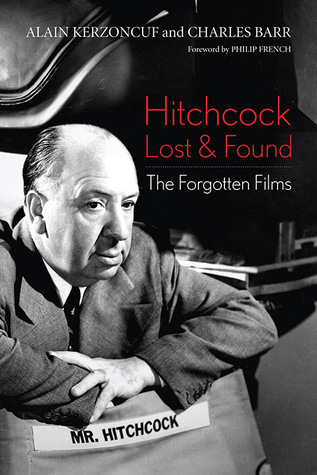In the crowded field of Alfred Hitchcock studies, Alain Kerzoncuf and Charles Barr present a surprisingly large amount of new information, copiously illustrated, in Hitchcock Lost and Found: The Forgotten Films (2015). They concentrate on his lesser-known work, when he was starting in the industry and at other stages, including small–scale projects he undertook during the war and in the later years of his career.
Both authors have previously published on Hitchcock, and Barr in particular is an established authority on Hitchcock.* They have conducted extensive archival research, and are careful not to rehash scholarship conducted by others, instead directing the reader to the relevant sources. They demonstrate how new insights can be gleaned even from subjects that at first glance appear well worked over.
After a discussion in the introduction of the ways in which Hitchcock’s films were used by various archives to assist their growth, and the role the archives played in helping to formulate a standard Hitchcock image, the authors focus on four main periods: his apprentice early days before The Pleasure Garden (1920-1925); the difficult transition to the sound era in the early 1930s; his wartime activities re-editing British propaganda for the American market; and minor projects during the Hollywood years.
The first part, the most detailed, looks at Hitchcock’s early years in England as a title writer and fledgling director, initially for Famous Player-Lasky’s British subsidiary and later for Michael Balcon (who was later so critical of Hitchcock’s decision to remain in the United States during the war) at Gainsborough. It examines all the films he worked on, or may have had some input, such as Number Thirteen and Always Tell Your Wife.
The authors highlight his enthusiasm for learning all aspects of the business and how quickly he learned by sponging up information, showing how the experiences helped to shape the mature filmmaker he was to become. The section also sheds light on a domestic film industry already simultaneously competing against and reliant on American finance. As well as unpacking obscure parts of Hitchcock’s career, it acknowledges his networking abilities and the contributions of his collaborators to his development.
Hitchcock was an early adopter of sound, and the second part examines his participation in the technological advances that occurred in the early 1930s. Many of the films Hitchcock worked on are better known than the earlier ones, Blackmail of course, but also Juno and the Paycock and Murder. This period saw Hitchcock come into his own as a director, but he was involved in many projects in a variety of capacities.
Kerzoncuf and Barr find new things to say about the films, particularly Murder’s German version, Mary, and Elstree Calling. There are oddities too, for example An Elastic Affair, a tie-in with a talent contest, Baird Television, purporting to be a television screening of an unidentified piece of Hitchcock film, and Let’s Go Bathing, a fashion parade ‘to show the resources of the Cotton Industry.’ These miscellaneous, and often unglamorous, activities indicate that his rise to prominence as a director was not a steady climb, but had troughs on the way.
Wartime work was carried out in parallel with his mainstream directing duties on both sides of the Atlantic (incurring David O Selznick’s displeasure). This included re-editing a couple of British propaganda films to appeal more to US sensibilities, making a bond appeal short, and directing two French-language films for the Ministry of Information, Bon Voyage and Aventure Malgache, the reception of which makes illuminating reading. He also assisted on Memory of the Camps, Sidney Bernstein’s abandoned documentary about the Nazi concentration camps.
A bonus of this close scrutiny of his wartime contributions is the convincing defence of him against the charge that staying in Hollywood during the war and not returning to England was unpatriotic. It is clear he did make significant contributions, probably more telling than if he had stayed in Britain for the duration. However, balancing this positive view of Hitchcock’s character, Kerzoncuf and Barr concede he had a tendency to discard people from whom he felt he had nothing further to learn.
The authors acknowledge the Hollywood career provides slimmer scope for discoveries but even so they manage to provide new information on projects with a rather lower profile than his feature films. These were a 1959 American Cancer Society TV programme, a witty, and rather unlikely, filmed contribution for the Cine Club in Westcliff, Essex in 1963, and a 1969 Scottish Television documentary on John Grierson.
As well as a study of some of Hitchcock’s output hitherto neglected by film historians, examining such elements as have survived and gaining an understanding of what has been lost (or hopefully only mislaid), the book is a call to assist in the rediscovery of other overlooked material lurking in archives or even lofts, not only by Hitchcock but by those who were connected to him, in order to deepen our understanding of the context in which Hitchcock’s work was produced.
It is likely he was involved in even more films, particularly in the early stages, but for which we do not have supporting evidence. Often, when it is lacking, supposition is required, but the authors never stray beyond what is plausible and are cautious in their conclusions. The result is a portrait of a significant director who created far more than the remarkable body of films for which he is already famous. It will be a key resource for future Hitchcock biographers.
Kerzoncuf and Barr modestly couch their book in terms of an ‘interim report’, expressing the hope it will encourage scholars to take up the baton and research Hitchcock’s less well-known work, perhaps one day resulting in a sequel, with additional film and document finds to scrutinise. They even suggest a series focusing on key figures in the industry: that would certainly be a worthwhile endeavour.
*Charles was also my PhD supervisor at the University of East Anglia.

